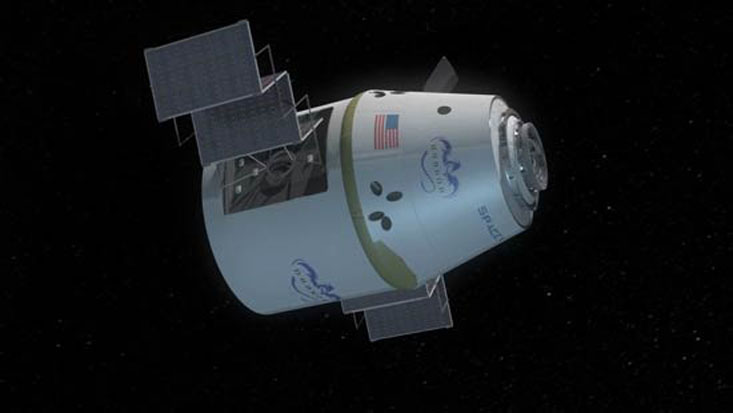SpaceX Aims for Mars with Reusable Rockets, Spaceships

LOS ANGELES — As SpaceX's Dragon capsule descended toward Earth, it was clear this landing was going to be different than previous ones.
Instead of falling toward the ocean and deploying parachutes — as SpaceX capsules have done several times after completing robotic cargo runs to the International Space Station for NASA — this Dragon spaceship was aiming for land. It fired its SuperDraco engines, extended four legs and made a pinpoint touchdown on a concrete landing pad not far from where it was launched into space.
"That is how a 21st century spaceship should land," SpaceX founder and CEO Elon Musk told a cheering crowd of employees and VIPs late late month as the landing — which was an animation, not an actual event — ended on two large video screens. [Meet Dragon V2: SpaceX's Manned Space Taxi]
Musk had just unveiled the first crewed version of SpaceX's spacecraft, known as Dragon V2, at SpaceX's headquarters in Hawthorne, Calif. The invitation-only event gave attendees — and thousands watching online — a view of the improved spacecraft and one of the clearest views yet of Musk's ambitious space goals.
"It is, all around, I think, really a big leap in technology. It really takes things to the next level," said Musk, describing upgrades to the ship that could allow Dragons to fly up to 10 times without significant refurbishment.
The spacecraft is the company's entry into NASA's commercial crew competition, whose main goal is the development of a private American vehicle that can safely transport seven astronauts to and from the space station.

SpaceX is competing with Boeing and Sierra Nevada Corp., which are developing a capsule called the CST-100 and a space plane called Dream Chaser, respectively. NASA is expected to award the next round of contracts in August. [Mars Sample-Return Idea with SpaceX Dragon (Images)]
Get the Space.com Newsletter
Breaking space news, the latest updates on rocket launches, skywatching events and more!
Musk doesn't want SpaceX to simply become an orbital taxi service, however. His dreams are far grander: to transform the way in which space exploration is conducted, opening up the final frontier to widespread and affordable use. Musk's vision doesn't end in Earth orbit but rather stretches all the way to the frozen deserts of Mars.
The key is reusability. Musk said the crewed Dragon is designed to land softly back on Earth and be rapidly turned around for another flight — possibly on the same day.
"The reason that this is really important is that, apart from the convenience of the landing location, is that it enables rapid reusability of the spacecraft," Musk told the audience.
"So, you can just reload the propellants and fly it again. This is extremely important for revolutionizing access to space, because as long as we continue to throw away rockets and spacecraft, we will never have true access to space; it will always be incredibly expensive," he added. "You can imagine a scenario where … if an aircraft was thrown away after each flight, nobody would be able to afford to fly. Or very few, only a small number of government customers. The same is true with rockets and spacecraft."
If SpaceX's engineers can pull it off, the crewed Dragon will launch on a Falcon 9 rocket that's also fully reusable. This past April, the first stage of a Falcon 9 maneuvered to a soft "landing" on the ocean, refiring its engines and extending four landing legs before hitting the water intact.
SpaceX's goal is to to recover a Falcon 9 first stage with a touchdown on land by the end of the year. The company would then re-launch the stage next year on a demonstration flight. The company's engineers are also working on the more difficult problem of trying to recover the Falcon 9's second stage, which reaches a much higher altitude.
Musk predicted that instead of flying into space a handful of times per year as we do now, humans would eventually be able to fly to space multiples times per day.
"I think 20 years for thousands of flights," Musk said in response to a question about increasing annual launch rates. "And I think we could probably get to the hundreds-of-flights level in 12 to 15 years."

Getting into space easily and cheaply would allow people to go almost anywhere in the solar system. Musk's focus is Mars. He has been talking to NASA about using a Dragon to land on the Red Planet, collect soil samples and send them back to Earth for analysis.
After that would come something even more ambitious — human settlement. Musk and his engineers are already designing a bigger launch vehicle that could send large payloads to the Red Planet. Musk wants to establish a colony on Mars, where he plans to retire.
But first things first: If NASA provides additional funding to SpaceX, Musk believes SpaceX could launch a crewed test flight of Dragon V2 in about two years and begin ferrying astronauts to the space station by the end of 2016. That would be a year earlier than NASA's current schedule.
Follow us @Spacedotcom, Facebook or Google+. Originally published on Space.com.
Join our Space Forums to keep talking space on the latest missions, night sky and more! And if you have a news tip, correction or comment, let us know at: community@space.com.










